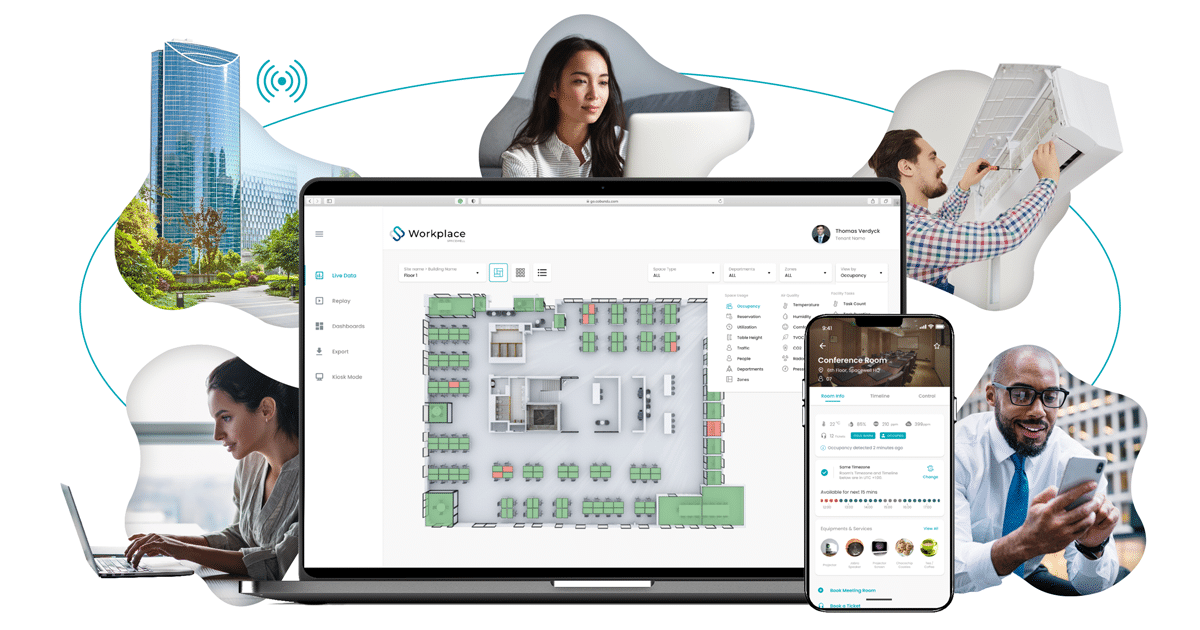For businesses, workplace management is a constantly growing challenge. Recent changes in work ethics now demand an effort to adapt and factor new constraints into the way offices and other workspaces are managed.
To meet these challenges while still improving profits, companies that want to stay ahead of the pack, therefore, need to identify the most relevant practices and tools to meet their goals.
What is workplace management?
The workplace management concept arose out of the new problems workspace managers are having to face. New practices, new technologies and the Covid-19 pandemic have led to profound changes in the way offices are used.
Suggested reading: The best facility management software for the post-pandemic world?
WFH, flex offices, open-space offices, and videoconferencing are becoming widespread phenomena and require workspace managers to show a strong capacity to adapt.
Workplace management aims to provide effective and innovative solutions to these new practices and the difficulties they can cause. For instance, the underuse of projection or video conferencing systems (e.g. 26″ HD screens) is common since they are only used for small group meetings. On the contrary, employees who want to isolate themselves to call a client or to concentrate sometimes have difficulty finding the right space.
Workplace management involves managing the work environment to factor in the different needs of the employees to be able to provide them with workspaces that promote their comfort, commitment, and productivity. This concept involves managing equipment and related services and implementing processes to achieve these objectives.
Suggested reading: What are the key advantages of space management software?

Why implement workplace management?
Difficulties in recruiting, new work habits, and the upsurge of new employee requirements in terms of the working environment are forcing companies to do their best to improve it. Several studies show both the importance of this issue for employees and the dissatisfaction of many of them with their working conditions.
Rather than responding to specific requests on an ad hoc basis, businesses would do well to implement a genuine strategy for managing the working environment, i.e. by developing their workplace management practices
What is a workplace manager?
While more and more businesses are creating a dedicated workplace manager job position, this new method of managing the working environment more generally involves all office and facility managers, as well as human resources departments and corporate property managers.
A workplace manager is entirely committed to the mental and physical well-being of the employees. His or her role is to organize the working space so as to make it pleasant and functional in all situations.
Facility managers are also involved in this process, as they are responsible for coordinating the organization of offices and managing associated services, such as catering or concierge services. Workplace management also helps them to allocate their resources optimally and to reduce costs related to the premises.
Human resources departments should also be involved in deploying a workplace management strategy, for instance by collecting and analyzing employees’ expectations and ensuring their safety.
Lastly, business property managers and operators are also involved, since this method can empower them to optimize their floor space earnings while delivering functional energy and environment-efficient working environments.
Better workplace management with an Integrated Workplace Management System (IWMS)
How can workplace management be implemented and improved in today’s world? Two main issues need to be considered: practices and tools.
A workplace manager’s best practices
Managing a working environment spans a very wide range of issues:
- equipment & facility layout and space management;
- the degree of employee satisfaction with their environment;
- space optimization;
- physical and health safety;
- flow automation and fluidity;
- and, of course, costs.
Generally speaking, the best practices are those that are conducive to rationalizing the way space is managed. An efficient workplace manager can successfully:
- collect accurate and relevant data on how employees use workspaces to support decision-making;
- monitor energy consumption and carbon footprints;
- manage data and monitor buildings and equipment consistently.
What are the key features of a workplace management solution?
To deploy these practices and achieve your objectives, you need the right digital tools. There are a lot of workplace management software solutions available today, so it is important to identify the key features they deliver.
A single gateway
To achieve consistent workspace management, it is essential to use a solution that centralizes all data and processes, including work orders. A heterogeneous software mix slows down tasks and impedes the flow and reliability of the information.
Suggested reading: Workplace App – All-in-One Global Workplace Solution

Asset management tool
The software you select must be able to manage the entire asset life cycle: work order creation and management as well as monitoring indicators and costs.
Integration and innovation
Effective workspace management requires the use of various workspace monitoring tools. Examples of these tools include IoT sensors, which can be used to monitor room occupancy rates or air quality. An efficient workplace management solution is therefore capable of collecting, processing, and analyzing the data sent to it by these instruments.
Suggested reading: How to improve your workplace management with IWMS?
Spacewell’s IWMS is the right solution for you
As an expert in facility management and a leader in IWMS, Spacewell delivers a solution that seamlessly fits all companies eager to improve their workplace management.
The Spacewell IWMS (Integrated Workplace Management System) has many advantages:
- flexibility: this standard-compliant software is highly configurable and provides external connectivity via standard web services;
- efficiency: this solution packs the best practices in workflow, automated ticket management and work order distribution based on the skills of each technician;
- easily usable information, thanks to real-time and historical KPI dashboards and highly ergonomic data display.
The IWMS solution packs a large number of features that make both facility management and maintenance easy, and delivers the most innovative technologies such as BIM or IoT plus supplier and service provider management capabilities.
While the challenges companies face to maximize employee engagement and keep up with the competition are numerous, the solutions to tackle them are also increasing in number. By choosing an IWMS software such as the one Spacewell offers, you can equip yourself with a major asset to achieve your workplace management objectives.






